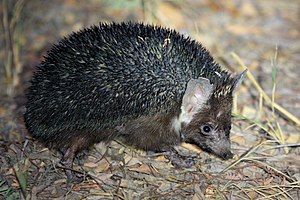Brandt's hedgehog
| Brandt's hedgehog | ||||||||||||
|---|---|---|---|---|---|---|---|---|---|---|---|---|

Brandt's hedgehog ( Paraechinus hypomelas ) |
||||||||||||
| Systematics | ||||||||||||
|
||||||||||||
| Scientific name | ||||||||||||
| Paraechinus hypomelas | ||||||||||||
| ( Brandt , 1836) |
Brandt's hedgehog ( Paraechinus hypomelas ) is a type of desert hedgehog within the hedgehog (Erinaceidae), which occurs with a total of five subspecies in Iran and neighboring countries, as well as in some regions of the Arabian Peninsula .
- Paraechinus hypomelas hypomelas lives in Turkmenistan , in the south-east of Uzbekistan , in the south-west of Tajikistan , in Iran and on the island of Charg .
- Paraechinus hypomelas blanfordi occurs in eastern Iran, Afghanistan and Pakistan west of the Indus.
- Paraechinus hypomelas eversmanni is at home in the southwest of Kazakhstan , in the west of Uzbekistan and in the northwest of Turkmenistan.
- Paraechinus hypomelas sabaeus occurs in some areas of the Arabian Peninsula.
- Paraechinus hypomelas seniculus is endemic to the Tunb Islands in the eastern Persian Gulf
features
Brandt's hedgehog reaches a head-trunk length of 13.6 to 29 centimeters and a tail of 1.8 to 3.8 centimeters in length. The hind feet are 30 to 46 millimeters long and the ears protruding over the spines are 36 to 55 millimeters long. The legs of the animals are relatively long for hedgehogs, the claws are short and sharp. The weight of the species has not yet been determined. The animals are blackish to dark brown in color. The light forehead of many hedgehog species is also dark in Brandt's hedgehog. Albinism has already been documented. The spines are 36 to 37 millimeters long, have a rough surface and a longitudinal groove. The tips of the spines and often the distal third of the spines are black. The belly side, head and legs are covered with a mix of black and gray hair. The throat is cream-colored to whitish.
Habitat and way of life
Brandt's hedgehog lives in deserts, steppes and other dry landscapes. In Pakistan, the animals are mainly found in stony and rocky areas. It is nocturnal and not very faithful to its location. Because of its long legs and short claws, Brandt's hedgehog does not dig well and he usually sleeps between stones under overhanging ledges and only occasionally in earthworks.
Brandt's hedgehog feeds mainly on insects. It also eats scorpions, other invertebrates, small vertebrates, including small snakes, the eggs of ground-nesting birds and fruits. In years when the desert locust ( Schistocerca gregaria ) appears in its "swarming phase", it has a very large share in the diet of Brandt's hedgehog. In summer the animals often eat ripe melons. The fruits of olive willow ( Elaeagnus ) and mulberries are another part of the diet.
The young of Brandt's hedgehogs are mainly born in late spring and early summer, in April and May. A female only has one to six young animals once a year, but in most cases three to four young animals. They open their eyes when they are 21 to 23 days old and get their first teeth when they are 26 to 28 days old. In mountainous areas that are still under the influence of the monsoon, the animals may reproduce throughout the year. A Brandt's hedgehog kept in human care lived to be seven years and two months.
Hazard and protection
The species is listed as Least Concern by the International Union for Conservation of Nature and Natural Resources (IUCN). However, regional populations are becoming increasingly isolated from one another because of the ongoing desertification.
Individual evidence
- ↑ a b c d e f Troy Best: Family Erinaceidae (Hedgehogs and Gymnures). In: Don E. Wilson and Russell A. Mittermeier (eds.): Handbook of the Mammals of the World. Volume 8: Insectivores, Sloths and Colugos. Lynx Edicions, Barcelona 2018, ISBN 978-84-16728-08-4 , pp. 288-330 (p. 324)
- ↑ Paraechinus hypomelas in the endangered Red List species the IUCN 2016 Posted by: Bhattacharyya, T. Srinivasulu, C. & Molur, S., 2016. Accessed on March 5 of 2019.
